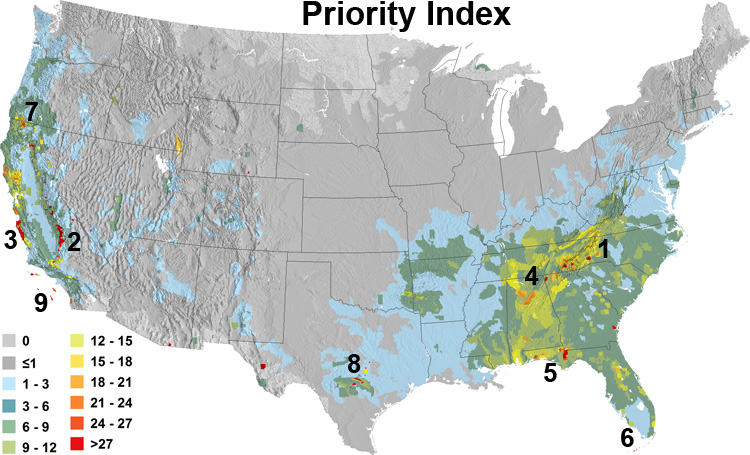
Priority areas for USA biodiversity conservation
The map below indicates areas of high priority for expansion of conservation in the USA to protect the nation’s unique species. It is based on an analysis of multiple groups of endemic species (amphibians, mammals, birds, freshwater fish, reptiles, and trees). Maps for each group can be found on other pages in this website. For a higher resolution version, click on the map below.
The research that produced this map is described in detail in the scientific paper, “U.S. protected lands mismatch biodiversity priorities,” by Clinton N. Jenkins, Kyle S. Van Houtan, Stuart L. Pimm, and Joseph O. Sexton. Published April 6, 2015, in Proceedings of the National Academy of Sciences. www.pnas.org/cgi/doi/10.1073/pnas.1418034112
Recommended Priority Areas indicated on the map:
1. Blue Ridge Mountains – Particularly the middle to southern sections, including the Cherokee, Nantahala, Pisgah, and Jefferson National Forests. This region is a major priority for amphibians, mainly due to salamanders, as well as for fish and trees. Much of the area is Federal land.
2. Sierra Nevada Mountains – Particularly the southern section. This region is a priority mainly due to amphibians and trees. Much of the area is Federal land.
3. California Coast Ranges – This region is a priority mainly due to trees, amphibians, and mammals. Substantial portions are Federal land.
4. Tennessee, Alabama, northern Georgia watersheds – This region is a priority mainly due to its exceptional fish diversity, for which it is globally significant. There is also substantial reptile and amphibian diversity in some areas. Most of the region is privately owned.
5. Florida panhandle – This region is a priority mainly due to trees, fish, and reptiles. Almost none of the region is within IUCN ranked protected areas. Most of the region is privately owned, but with some Federal and State lands.
6. Florida Keys – A priority mostly due to trees. A moderate amount of the Keys is within IUCN ranked protected areas and other public lands.
7. Klamath Mountains – Primarily along the border of Oregon and California. This priority is mainly due to trees, and somewhat to amphibians, and fish. Much of the area is Federal land.
8. South-Central Texas around Austin and San Antonio – This represents a cluster of sites that are priorities mainly due to amphibians, but also fish and reptiles. This is nearly all privately owned.
9. Channel Islands of California – The Channel Islands are priorities mainly due to trees, reptiles, and mammals. Significant portions of the islands are within IUCN ranked protected areas, or are Federal land.
